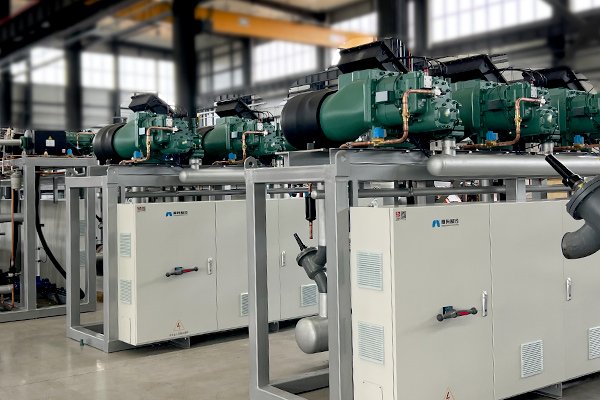Analysis of nine common faults and causes of refrigeration units

1. Common causes and analysis of high voltage alarms
(1)The cooling water (or air) flow rate is too small and cannot take away the condensation heat of the compressor;
(2)The cooling water (or air) temperature is too high, the heat exchange is not good, and the condensation heat of the compressor cannot be taken away;
(3)There is air in the system, which increases the condensation pressure;
(4)The refrigerant charge is too much and the liquid occupies the effective condensation area, causing the condensation pressure to increase;
(5)The condenser is in disrepair for a long time and the heat transfer surface is seriously dirty (or the air-cooled condenser is too dirty), which can also cause the condensation pressure to increase. The presence of scale also has a greater impact on condensation pressure.
2. Common causes and analysis of low voltage alarms
(1)The opening of the expansion valve is too small;
(2)The refrigeration system lacks refrigerant;
(3)The capillary tube or expansion valve is blocked;
(4)Filter clogged;
(5)Insufficient air volume of the internal unit;
(6)The evaporator is severely frosted;
3. Common causes and analysis of oil pressure difference controller alarms
(1)Insufficient refrigeration oil causes insufficient oil level in the compressor crankcase and the oil pump cannot absorb oil;
(2)The refrigeration oil is dirty, causing the oil pump filter to become clogged;
(3)The oil pressure difference relay failed;
(4)Oil pump failure;
(5)There is a large amount of Freon in the refrigeration oil, which prevents the oil pressure from being established;
(6)Serious fluid return;
4. Common causes and analysis of compressor thermal protection
(1)The return air volume of the system is insufficient and the motor is not fully cooled;
(2)Abnormal power supply voltage, phase loss, motor overload;
(3)Condensation pressure is too high, etc.;
(4)Overheating phenomena such as high motor temperature, excessive exhaust temperature, and scorched lubricating oil are caused;
5. Common causes and analysis of poor cooling effect
(1)Expansion valve opening is too large or too small
(2)The refrigeration system is blocked, or the relevant valves are not opened or not fully opened, the solenoid valve is malfunctioning, etc.;
(3)Not enough refrigerant;
(4)Internal structural failure of the compressor;
6. Common causes and analysis of exhaust temperature alarms
(1)The suction pressure is too low, the suction and exhaust pressure difference is too large, and the opening of the expansion valve is small;
(2)The suction temperature is too high, that is, the suction superheat is high, the suction pipe is too long or the insulation effect is poor;
(3)Insufficient cooling water or too high water temperature;
(4)Too much air in the system;
(5)The condensation pressure is too high, and the corresponding condensation temperature is also high, causing the exhaust temperature to rise;
7. Common causes and analysis of serious evaporator frosting
(1)The evaporator fan has insufficient air volume and poor heat exchange;
(2)The evaporator is too dirty, which affects the heat exchange of the evaporator;
(3)Too much refrigerant enters the evaporator, resulting in insufficient heat exchange;
(4)The temperature is too low and the humidity is too high;
8. Common causes and analysis of poor oil return in refrigeration systems
(1)The oil return filter is dirty and blocked, and the oil return pipeline is dirty and blocked, causing the oil to not return;
(2)The oil separator is used for too long and its efficiency decreases;
(3)The exhaust temperature is too high and the efficiency of oil separation decreases;
(4)There is no oil return bend in the suction pipe, causing oil to be stored in the evaporator or other air pipes;
(5)The expansion valve opening is too small and the refrigerant gas flow rate in the suction pipe is too low to bring the oil back to the compressor;
9. Common causes and analysis of compressor suction temperature being too high
(1)Insufficient refrigerant, the refrigerant has overheated in the evaporator;
(2)The expansion valve is blocked or the pipeline is blocked, causing insufficient refrigerant in the evaporator;
(3)The opening of the expansion valve is too small or the throttling mechanism is faulty;
(4)The suction pipe is too long or the suction pipe is not well insulated;




